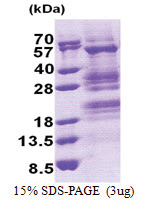TADA3L (1-432, His-tag) Human Protein
Other products for "TADA3"
Specifications
| Product Data | |
| Species | Human |
| Expression Host | E. coli |
| Expression cDNA Clone or AA Sequence |
MGSSHHHHHH SSGLVPRGSH MGSMSELKDC PLQFHDFKSV DHLKVCPRYT AVLARSEDDG IGIEELDTLQ LELETLLSSA SRRLRVLEAE TQILTDWQDK KGDRRFLKLG RDHELGAPPK HGKPKKQKLE GKAGHGPGPG PGRPKSKNLQ PKIQEYEFTD DPIDVPRIPK NDAPNRFWAS VEPYCADITS EEVRTLEELL KPPEDEAEHY KIPPLGKHYS QRWAQEDLLE EQKDGARAAA VADKKKGLMG PLTELDTKDV DALLKKSEAQ HEQPEDGCPF GALTQRLLQA LVEENIISPM EDSPIPDMSG KESGADGAST SPRNQNKPFS VPHTKSLESR IKEELIAQGL LESEDRPAED SEDEVLAELR KRQAELKALS AHNRTKKHDL LRLAKEEVSR QELRQRVRMA DNEVMDAFRK IMAARQKKRT PTKKEKDQAW KTLKERESIL KLLDG
|
| Tag | His-tag |
| Predicted MW | 51.3 kDa |
| Concentration | lot specific |
| Purity | >80% by SDS - PAGE |
| Buffer | Presentation State: Purified State: Liquid purified protein Buffer System: 20 mM Tris-HCl buffer (pH 8.0) containing 0.2M NaCl, 50% glycerol, 2mM DTT |
| Preparation | Liquid purified protein |
| Protein Description | Recombinant human TATD3 protein, fused to His-tag at N-terminus, was expressed in E.coli and purified by using conventional chromatography techniques. |
| Storage | Store undiluted at 2-8°C for one week or (in aliquots) at -20°C to -80°C for longer. Avoid repeated freezing and thawing. |
| Stability | Shelf life: one year from despatch. |
| Reference Data | |
| RefSeq | NP_001265199 |
| Locus ID | 10474 |
| UniProt ID | O75528, A8K899 |
| Cytogenetics | 3p25.3 |
| Synonyms | ADA3; hADA3; NGG1; STAF54; TADA3L |
| Summary | DNA-binding transcriptional activator proteins increase the rate of transcription by interacting with the transcriptional machinery bound to the basal promoter in conjunction with adaptor proteins, possibly by acetylation and destabilization of nucleosomes. The protein encoded by this gene is a transcriptional activator adaptor and a component of the histone acetyl transferase (HAT) coactivator complex which plays a crucial role in chromatin modulation and cell cycle progression. Along with the other components of the complex, this protein links transcriptional activators bound to specific promoters, to histone acetylation and the transcriptional machinery. The protein is also involved in the stabilization and activation of the p53 tumor suppressor protein that plays a role in the cellular response to DNA damage. Alternate splicing results in multiple transcript variants of this gene. [provided by RefSeq, May 2013] |
| Protein Families | Transcription Factors |
Documents
| FAQs |
Resources
Recombinant Protein Resources |
{0} Product Review(s)
0 Product Review(s)
Submit review
Be the first one to submit a review
Product Citations
*Delivery time may vary from web posted schedule. Occasional delays may occur due to unforeseen
complexities in the preparation of your product. International customers may expect an additional 1-2 weeks
in shipping.






























































































































































































































































 Germany
Germany
 Japan
Japan
 United Kingdom
United Kingdom
 China
China
